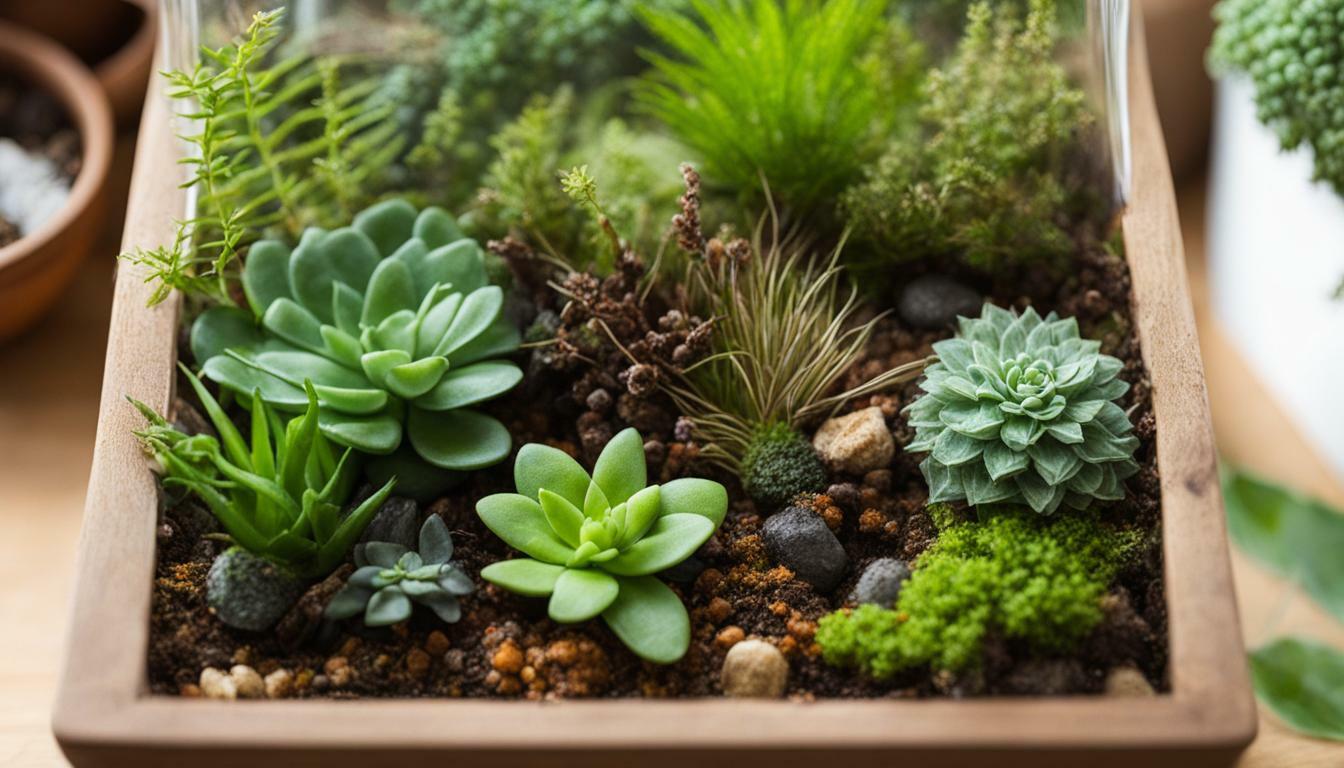Keeping pests away from your terrarium is crucial for maintaining a healthy and thriving miniature ecosystem. To ensure the well-being of your terrarium plants, it is important to follow proper pest prevention techniques. By implementing the right practices and taking proactive measures, you can create a pest-free environment for your terrarium.
Key Takeaways:
- Proper lighting is essential for terrariums. Supplemental light sources like grow lights or fluorescent lights can be used to provide the necessary light for your plants.
- Avoid placing your terrarium in direct sunlight or near heat sources like radiators, as this can lead to overheating and damage to the plants.
- Maintain a balanced moisture level by using a spray bottle instead of a watering can to avoid over-watering. Be mindful of the specific water needs of your terrarium plants.
- Select the right plants for your terrarium, considering their light and moisture requirements. Avoid using succulents in closed terrariums, as the humid environment may not be suitable for them.
- Regular maintenance, including cleaning, pruning, and removing diseased plants, is necessary to keep your terrarium healthy and prevent the spread of problems.
By following these tips and investing time in proper terrarium care, you can create a flourishing and pest-free environment for your beloved terrarium plants. Remember to consult experts if you encounter any challenges or need additional guidance along the way.
Common Mistakes to Avoid in Terrarium Care
When it comes to terrarium care, preventing pests starts with avoiding common mistakes that can make your miniature ecosystem vulnerable. Maintaining a healthy environment for your terrarium plants requires a combination of proper lighting, balanced moisture levels, and good hygiene practices. By avoiding these common pitfalls, you can ensure that your terrarium remains pest-free and thrives.
1. Placing your terrarium in direct sunlight: While some terrarium plants thrive in bright, indirect light, direct sunlight can cause excessive heat and damage the delicate ecosystem. Instead, choose a spot with filtered or indirect light to provide the optimal growing conditions for your plants.
2. Over-watering: It’s important to strike a balance with watering your terrarium. Over-watering can lead to root rot and create a breeding ground for pests. Instead of using a watering can, consider misting your terrarium with a spray bottle to provide moisture without saturating the soil.
3. Neglecting proper ventilation: Proper airflow is crucial in preventing the growth of mold, fungus, and other pests in your terrarium. Make sure to open the lid periodically to allow fresh air in and excess moisture to escape. If you notice condensation forming on the glass, it’s a sign that your terrarium may need better ventilation.
| Common Mistakes to Avoid in Terrarium Care | Impact |
|---|---|
| Placing your terrarium in direct sunlight | Excessive heat and damage to the ecosystem |
| Over-watering | Root rot and ideal conditions for pests |
| Neglecting proper ventilation | Mold, fungus, and pest infestation |
By avoiding these common mistakes, you can create a healthier environment for your terrarium and ensure the well-being of your plants. Understanding and implementing best practices for pest prevention will help your terrarium thrive and become a beautiful addition to your home or office.
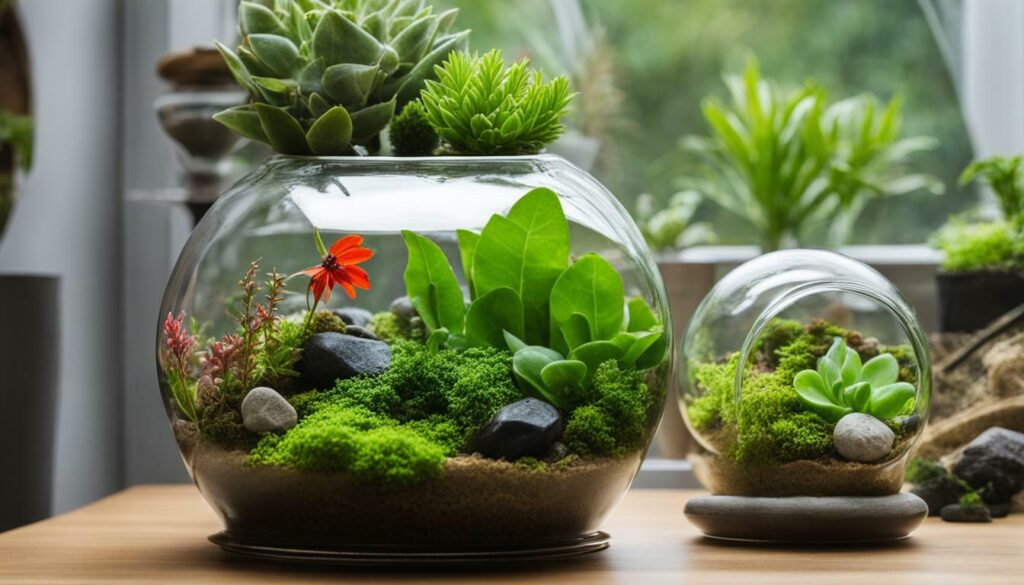
Adequate lighting not only promotes plant growth in terrariums but also plays a crucial role in preventing pests from infesting your miniature oasis. The right amount of light helps maintain a healthy and balanced terrarium environment, discouraging the growth of pests and ensuring the well-being of your plants.
When it comes to terrarium lighting, natural sunlight is ideal. Placing your terrarium near a window with filtered or indirect sunlight can provide the necessary light for most plants. However, it’s essential to avoid exposing your terrarium to direct sunlight, as it can cause overheating and damage to the plants.
If natural sunlight is not sufficient or accessible, you can supplement it with artificial lighting. Grow lights or fluorescent lights are excellent options for providing the necessary light spectrum for terrarium plants. These types of lights mimic natural sunlight and can be adjusted to match the specific lighting needs of your terrarium.
| Type of Lighting | Benefits |
|---|---|
| Natural sunlight | Provides essential light spectrum |
| Grow lights | Mimics natural sunlight |
| Fluorescent lights | Adjustable to match lighting needs |
Remember to clean the glass of your terrarium regularly to ensure proper light penetration. Dust and grime can obstruct light, reducing its effectiveness for your plants. Wiping the glass with a soft cloth or using a mild glass cleaner can help maintain optimal lighting conditions.
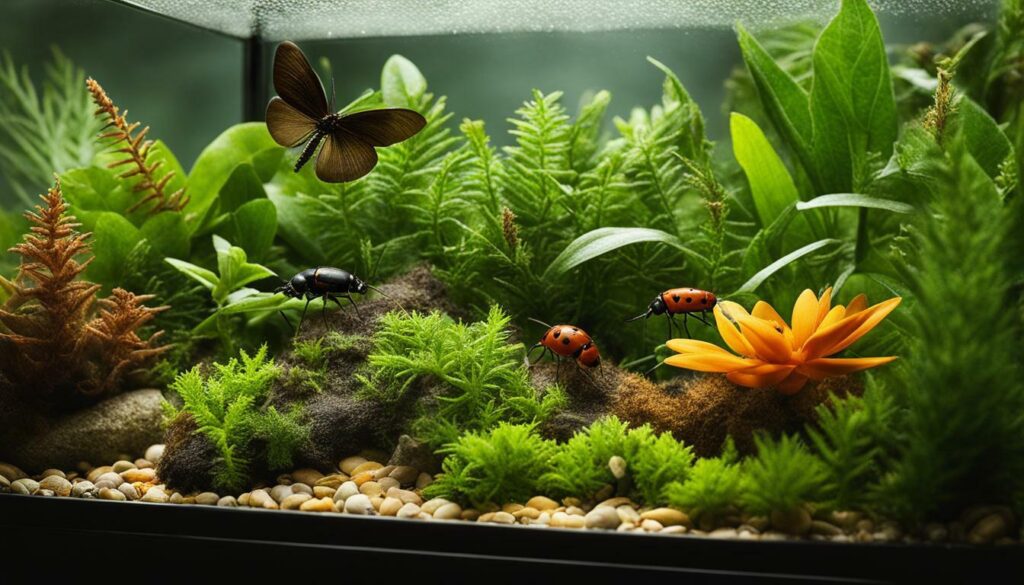
By providing adequate lighting in your terrarium, you create an environment that is not only visually pleasing but also inhospitable to pests. It allows your plants to thrive while mitigating the risk of pest infestation, ensuring the long-term success of your terrarium.
Maintaining the Terrarium Environment
Creating a pest-free environment in your terrarium involves proper maintenance and adopting effective pest prevention techniques. To ensure the health and longevity of your terrarium plants, it is essential to avoid common mistakes and take proactive measures.
One of the key aspects of maintaining a healthy terrarium environment is providing proper lighting. Placing your terrarium in direct sunlight or near heat sources can lead to overheating and damage to the plants. Supplemental lighting can be used with grow lights or fluorescent lights to provide the necessary light for plant growth. Regularly cleaning the glass of your terrarium is also crucial for optimal light penetration.
Another important factor to consider is the moisture level in your terrarium. Over-watering can create conditions that are conducive to pest infestation and the growth of mold and fungus. Instead of using a watering can, it is advisable to use a spray bottle to add moisture and prevent excess water accumulation. Additionally, promptly pruning and removing any diseased plants can help prevent the spread of problems within the terrarium.
| Tips for Maintaining a Healthy Terrarium Environment: |
|---|
| 1. Select plants with similar light and moisture requirements. |
| 2. Avoid placing terrariums in direct sunlight or near heat sources. |
| 3. Clean the glass regularly for optimal light penetration. |
| 4. Use a spray bottle for controlled moisture rather than over-watering. |
| 5. Prune and remove diseased plants promptly to prevent spread. |
During the settling-in period of a new terrarium, extra care and attention are required. It is essential to monitor and maintain the balance of moisture and humidity levels. This can be achieved by keeping the terrarium lightly misted and ensuring proper ventilation.
By following these tips and implementing effective pest prevention techniques, you can create a healthy and thriving environment for your terrarium plants. Regular maintenance, such as cleaning, pruning, and replacing dead plants, is necessary to keep your terrarium in optimal condition. If you encounter any pest or plant health issues, it is always recommended to consult experts for guidance and assistance.
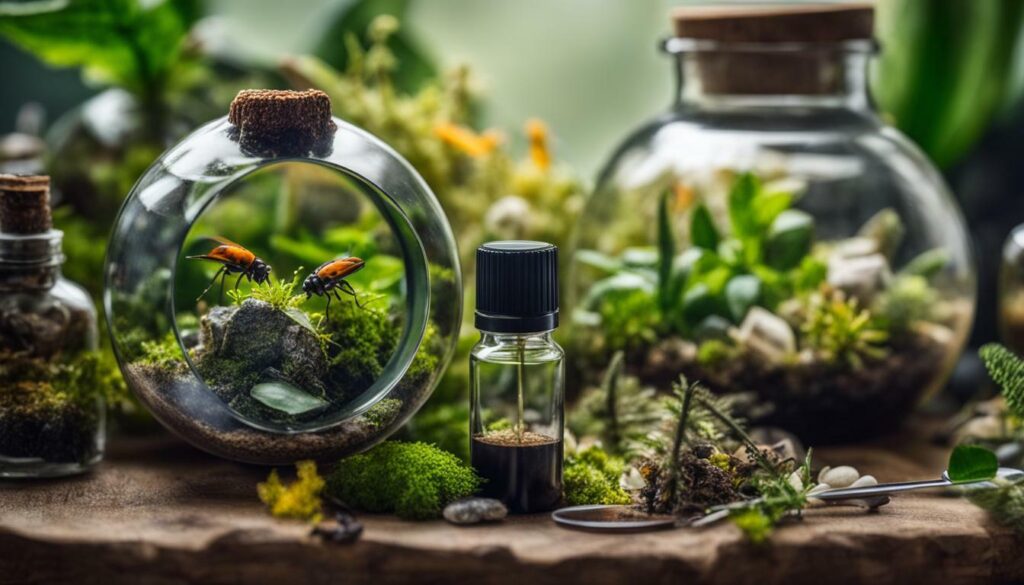
Selecting the right plants for your terrarium not only ensures aesthetic appeal but also plays a key role in keeping pests at bay. Different plants have varying light and moisture requirements, and it is important to consider these factors when creating your terrarium ecosystem. By choosing the right plants, you can create a harmonious environment that is less susceptible to pest infestations.
When selecting plants for your terrarium, it is essential to choose species that are well-suited for the type of terrarium you have. Closed terrariums, for example, create a more humid environment that is ideal for tropical plants like ferns and mosses. These plants thrive in high humidity and can help regulate moisture levels within the enclosed space. Open terrariums, on the other hand, provide more airflow and are better suited for plants that prefer drier conditions, such as succulents and cacti.
In addition to considering the type of terrarium, it is important to choose plants that have similar light and moisture requirements. Grouping plants with similar needs together will make it easier to provide the appropriate conditions for their growth. For example, if you have a terrarium with high light conditions, choose plants that thrive in full sun or bright indirect light. On the other hand, if your terrarium is in a location with low light levels, opt for plants that are more shade-tolerant.
| Plant Type | Light Requirements | Moisture Requirements |
|---|---|---|
| Tropical Ferns | Medium to Bright Indirect Light | High Humidity |
| Mosses | Low to Medium Indirect Light | High Humidity |
| Succulents | Bright Direct Light | Low to Moderate Watering |
Remember that succulents are not suitable for closed terrariums as the humid environment can cause them to rot. It is important to research the specific requirements of each plant before adding them to your terrarium. This will ensure that all the plants in your terrarium remain healthy and thrive, creating a beautiful and pest-resistant ecosystem.
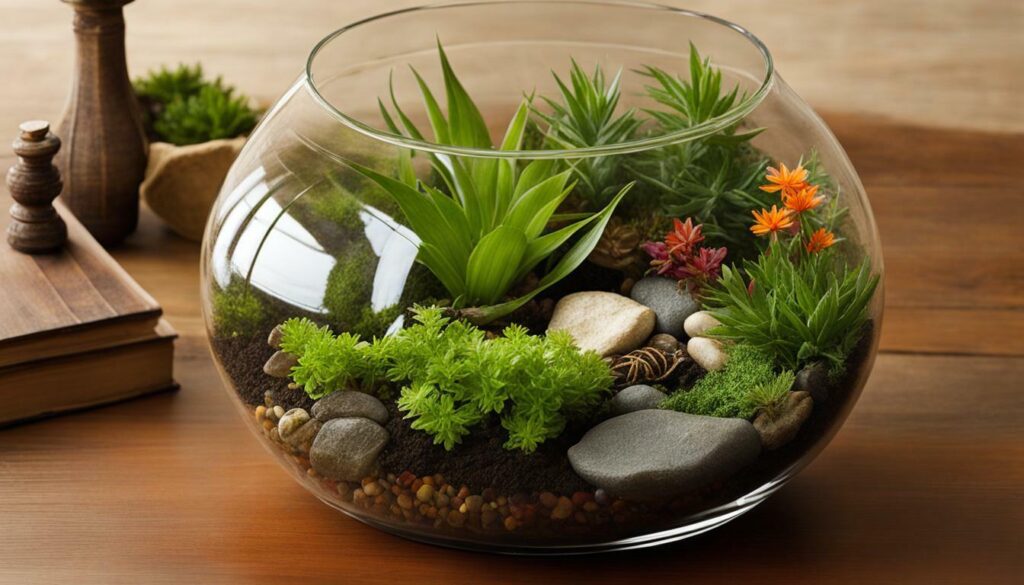
By carefully selecting the right plants for your terrarium and providing them with the appropriate light and moisture levels, you can create a thriving and pest-free environment. Remember to regularly monitor your terrarium, maintain proper ventilation, and practice good hygiene to prevent any potential pest issues. By following these guidelines, you can enjoy a stunning and healthy terrarium that brings a piece of nature into your home.
Settling-In Period and Terrarium Health
The settling-in period of a new terrarium is crucial, and taking extra care during this time is essential to prevent potential pest problems. It is important to create a balanced environment that supports the growth and health of your plants while minimizing the risk of pest infestation. Here are some best practices for ensuring a successful settling-in period and maintaining terrarium health in the long run.
Firstly, it is essential to monitor the moisture levels in your terrarium. While it is important to maintain a humid environment, excessive moisture can create a favorable breeding ground for pests such as fungus gnats and mold. Regularly check the soil and adjust the watering schedule accordingly. Remember to use a spray bottle for watering to avoid over-watering and ensure even distribution.
During the settling-in period, it is common for plants to experience some transplant shock. To mitigate this, keep your terrarium away from direct sunlight and extreme temperatures. Gradually introduce your terrarium to more light over time, allowing the plants to adjust and minimize stress. Ensure that ventilation in the terrarium is adequate, allowing for air circulation and preventing the buildup of excess moisture.
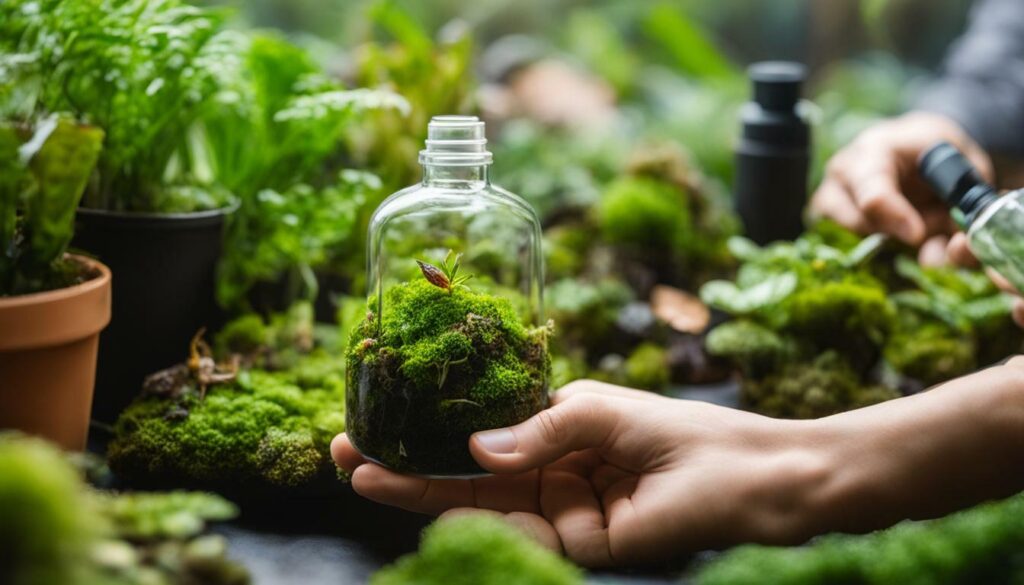
Regularly inspect your terrarium for any signs of pests or diseases. Early detection is key in preventing potential infestations and minimizing the spread of problems. Inspect the leaves, stems, and soil for any indications of pests, such as tiny insects, webs, or discoloration. If you notice any issues, promptly remove affected plants and treat the terrarium with appropriate insecticides or natural pest control methods.
By following these best practices during the settling-in period and beyond, you can establish a healthy environment for your terrarium plants and prevent pest problems. Remember to maintain good hygiene, monitor moisture levels, and provide suitable lighting and ventilation. If you encounter any challenges or have specific concerns, it is always advisable to seek advice from experts in terrarium care. With proper care and attention, your terrarium can thrive and bring natural beauty into your home or office.
Ventilation and Moisture Control
Maintaining adequate ventilation and moisture control in your terrarium is key to pest prevention and ensuring a healthy ecosystem. Proper airflow and humidity levels help create an environment that is less conducive to pests and diseases. Here are some tips and techniques to help you achieve optimal ventilation and moisture control:
- Position your terrarium in a well-ventilated area, away from direct sunlight and heat sources. This will prevent excessive moisture buildup and ensure proper air circulation.
- Keep the terrarium lid slightly ajar or use a mesh cover to allow for air exchange. This will help prevent the growth of mold and fungi, which can attract pests.
- Monitor the moisture levels regularly using a hygrometer and adjust accordingly. Different plants have different moisture requirements, so it’s important to find the right balance for your terrarium.
- Avoid over-watering your terrarium. Instead, use a spray bottle to mist the plants and soil lightly. This will provide the necessary moisture without creating a damp environment that pests thrive in.
- If you notice condensation forming on the terrarium walls, it’s a sign of excessive moisture. Wipe it off with a clean cloth to maintain a healthy humidity level.
Remember to regularly clean the terrarium glass to allow maximum light penetration. This will ensure that your plants receive adequate light and promote their overall health. Additionally, good hygiene practices, such as removing dead leaves and debris, will prevent pests from finding a breeding ground in your terrarium.
By paying attention to ventilation and moisture control, you can create an environment that not only keeps pests at bay but also promotes the wellbeing of your terrarium plants. With proper care and maintenance, your terrarium will thrive and become a beautiful focal point in your home or office.
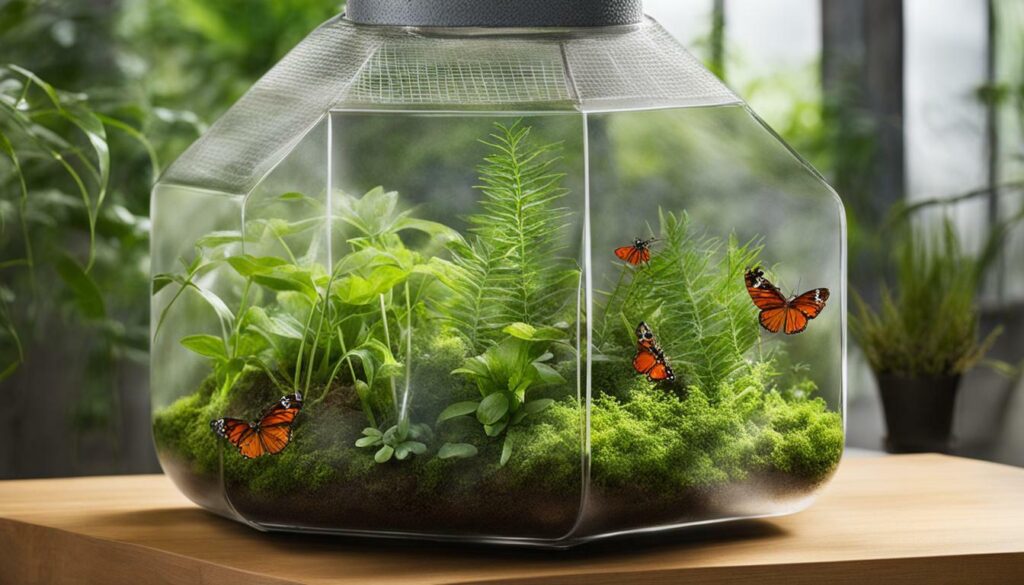
| Pest | Prevention techniques |
|---|---|
| Aphids | Regularly inspect and remove infested plants. Introduce natural predators like ladybugs or use insecticidal soap. |
| Fungus Gnats | Avoid overwatering and allow the soil to dry out between waterings. Use sticky traps to catch adult gnats. |
| Spider Mites | Increase humidity levels to deter spider mites. Regularly mist the plants and gently wipe the leaves to remove any mites. |
| Mealybugs | Isolate infested plants immediately and treat with insecticidal soap. You can also use cotton swabs dipped in rubbing alcohol to remove the bugs manually. |
Hygiene and Regular Maintenance
Good hygiene practices and regular maintenance are essential for preventing pests and ensuring the longevity of your terrarium. By following these simple steps, you can create a clean and healthy environment for your terrarium plants:
- Clean the glass: Regularly clean the glass of your terrarium to allow for maximum light penetration. Use a soft cloth or paper towel dampened with water to gently remove any dirt or smudges.
- Avoid over-watering: Over-watering can create a damp environment that is ideal for pests to thrive. Instead of using a watering can, use a spray bottle to mist your terrarium plants. This will provide them with the necessary moisture without saturating the soil.
- Prune and remove diseased plants: Promptly prune and remove any diseased or dying plants from your terrarium. This will prevent the spread of problems and maintain the overall health of your terrarium.
- Select the right plants: Choose plants that are suitable for the type of terrarium you have. Ensure that they have similar light and moisture requirements to avoid imbalances that can attract pests.
Regular maintenance is key to keeping your terrarium in good condition. Here are a few additional tips:
- Monitor moisture levels: Regularly check the moisture levels in your terrarium. If the soil is consistently too wet or too dry, adjust your watering schedule accordingly.
- Maintain proper ventilation: Proper airflow is crucial for preventing issues like mold and fungus. Ensure that your terrarium has adequate ventilation to allow fresh air to circulate.
- Practice good hygiene: Keep your terrarium clean and free from debris. Remove any dead leaves or fallen plant material, as they can attract pests.
By following these hygiene practices and regularly maintaining your terrarium, you can effectively control pests and enjoy a thriving and beautiful miniature garden in your home.
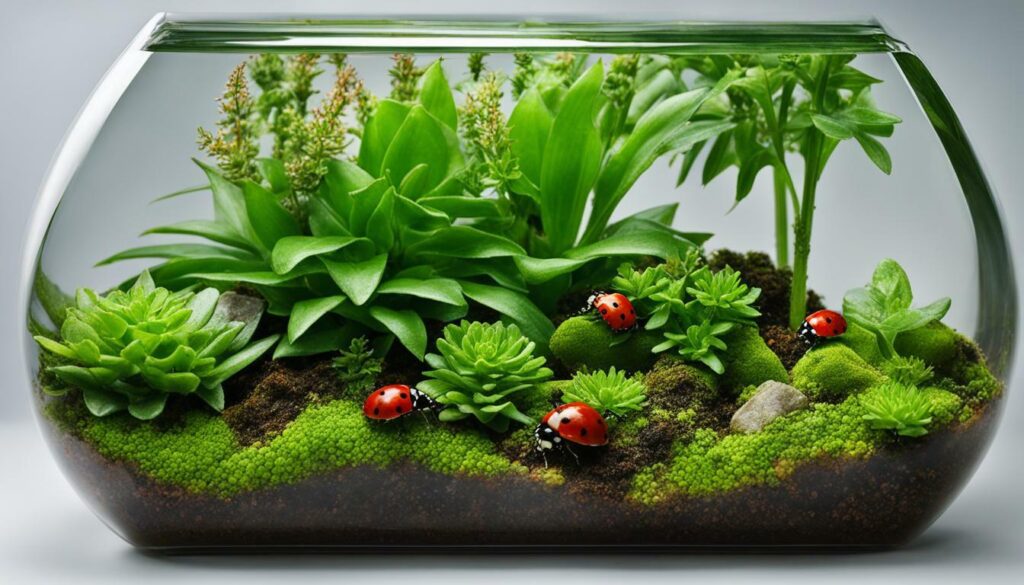
| Key Points: | Benefits: |
|---|---|
| Regularly clean the glass | Maximize light penetration |
| Avoid over-watering | Prevent damp conditions for pests |
| Prune and remove diseased plants | Prevent spread of problems |
| Select the right plants | Maintain balance and prevent imbalances |
| Monitor moisture levels | Ensure optimal conditions |
| Maintain proper ventilation | Prevent mold and fungus |
| Practice good hygiene | Avoid attracting pests |
Addressing Common Terrarium Pests
While prevention is key, it’s important to be prepared to address common pests that may find their way into your terrarium. Despite your best efforts, pests can sometimes still infiltrate your terrarium and wreak havoc on your plants. Here are some common pests you may encounter and how to address them effectively:
Aphids
Aphids are small insects that feed on the sap of plants, causing leaves to curl and distort. To combat these pesky pests, you can introduce natural predators like ladybugs or lacewings to your terrarium. Alternatively, you can create a homemade aphid spray by mixing water with a few drops of dish soap and neem oil. Spray this solution on the affected plants to deter aphids.
Fungus Gnats
Fungus gnats are tiny insects that are attracted to moist soil and decaying organic matter. To eliminate these pests, allow the top layer of soil in your terrarium to dry out between waterings. You can also use yellow sticky traps to catch adult gnats, preventing them from laying eggs in the soil. If the infestation persists, you can apply a natural insecticide specifically designed for fungus gnats.
Spider Mites
Spider mites are tiny insects that can cause significant damage to your terrarium plants. They feed on plant cells, causing leaves to yellow and develop tiny webs. To control spider mites, regularly mist your plants with water to increase humidity. You can also introduce predatory mites or lacewings to feed on the spider mites. Another effective method is to wipe down the affected leaves with a mixture of water and dish soap, ensuring to cover both sides of the leaves.
| Pest | Solution |
|---|---|
| Aphids | Introduce natural predators or use homemade aphid spray |
| Fungus Gnats | Allow soil to dry between waterings and use sticky traps or natural insecticides |
| Spider Mites | Increase humidity, introduce predatory mites or wipe leaves with soapy water |
By promptly addressing common pests in your terrarium, you can protect your plants and ensure their optimal health. Remember to monitor your terrarium regularly for signs of infestation and take immediate action to prevent the pests from spreading. With proper care and attention, you can maintain a pest-free environment for your terrarium plants.
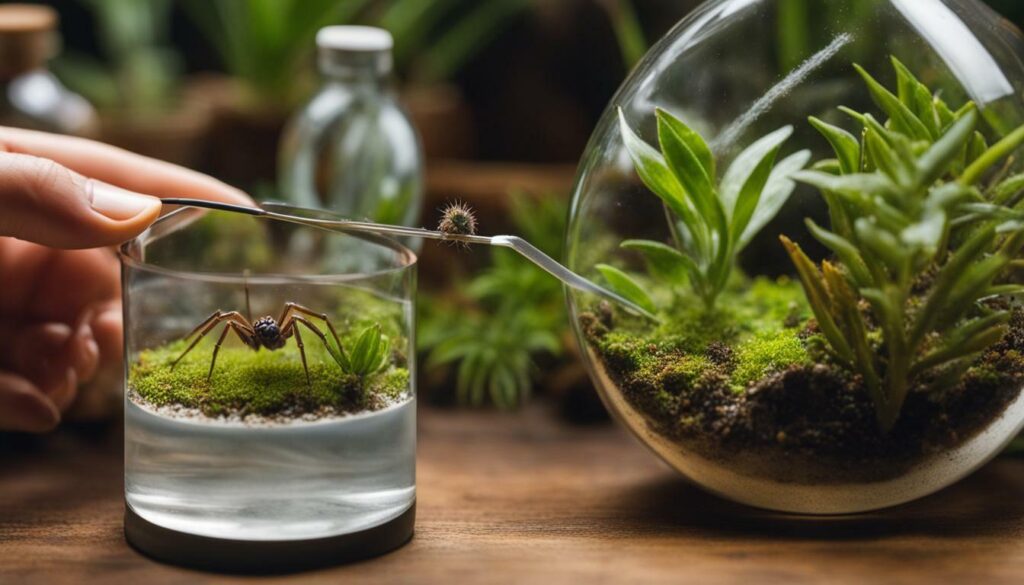
Note: The image above is for illustrative purposes only and does not represent a specific pest species found in terrariums.
Seeking Expert Advice
If you encounter persistent or challenging pest problems in your terrarium, seeking professional advice can help you effectively manage the situation. Experts in terrarium pest control and management have the knowledge and experience to identify specific pests, understand their lifecycles, and recommend targeted solutions. They can guide you in choosing the most appropriate and safest pest control methods for your terrarium, ensuring the health and well-being of your plants.
Professional advice can be especially beneficial when dealing with more complex pest issues or when the safety of your terrarium’s inhabitants is a concern. Experts can provide valuable insights on integrated pest management techniques, which focus on preventing and controlling pests while minimizing environmental impact. They can also offer advice on natural and organic pest control methods, helping you maintain a sustainable and eco-friendly terrarium.
In addition to pest control, experts can provide guidance on overall terrarium care, including proper lighting, humidity management, and plant selection. They can help you troubleshoot any problems you may encounter and offer practical solutions tailored to your specific terrarium setup.
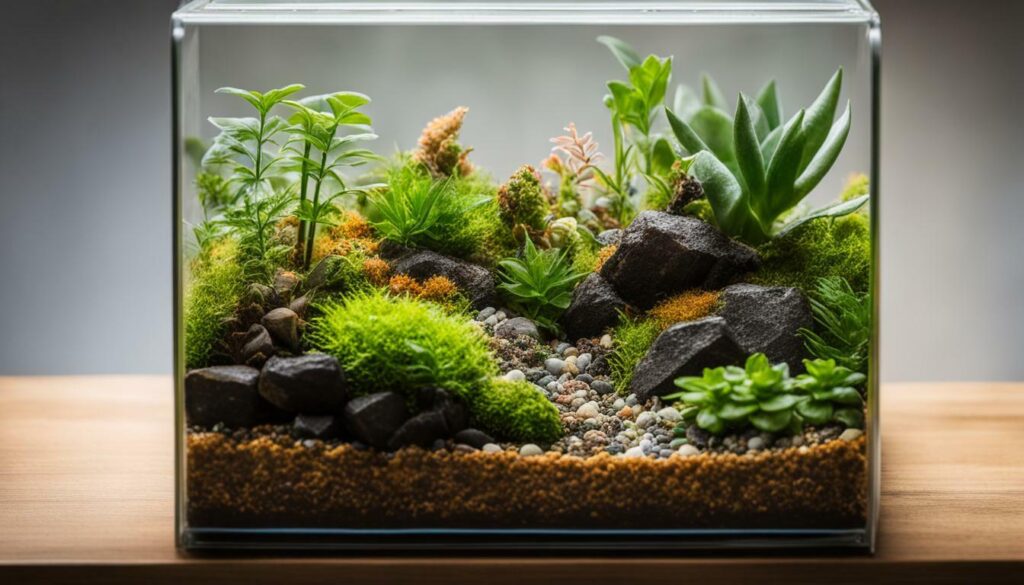
Remember that prevention is always better than cure when it comes to pest management in your terrarium. Regular monitoring, good hygiene practices, and proper maintenance are crucial in preventing pest infestations. However, if pests do become a problem, seeking expert advice can be a valuable resource in helping you restore the balance and health of your terrarium.
Expert Tip:
“Don’t hesitate to contact a professional if you’re unsure about how to handle a pest issue in your terrarium. They can provide personalized advice and save you time and effort in finding the right solutions.”
| Key Takeaways |
|---|
| Seek professional advice for persistent or challenging pest problems in your terrarium. |
| Experts can identify pests, understand their lifecycles, and recommend targeted solutions. |
| They can guide you in choosing safe and effective pest control methods. |
| Experts can provide insights on integrated pest management and natural pest control. |
| They can offer advice on overall terrarium care, including lighting and plant selection. |
Regular Monitoring and Troubleshooting
Regularly monitoring your terrarium’s health and promptly addressing any signs of pest infestation is crucial for its long-term success. To ensure a thriving terrarium ecosystem, it’s essential to stay vigilant and take necessary measures to prevent and manage pests.
One effective way to monitor your terrarium is by conducting routine inspections. Carefully examine the plants, soil, and the overall appearance of the terrarium for any signs of pests such as webs, holes in leaves, or discoloration. If you spot any pests, it’s important to take action promptly to prevent further damage.
To troubleshoot pest issues, first identify the specific pest causing the problem. Common terrarium pests include aphids, mealybugs, spider mites, and fungus gnats. Once you’ve identified the pest, research the appropriate treatment method. In some cases, you may be able to remove the pests manually or with a gentle spray of water. For more stubborn infestations, organic pest control options, such as neem oil or insecticidal soap, can be used.
As an extra precaution, isolate any infected plants from the rest of the terrarium to prevent the infestation from spreading. Regularly clean and sterilize any tools or equipment you use in the terrarium to avoid cross-contamination.
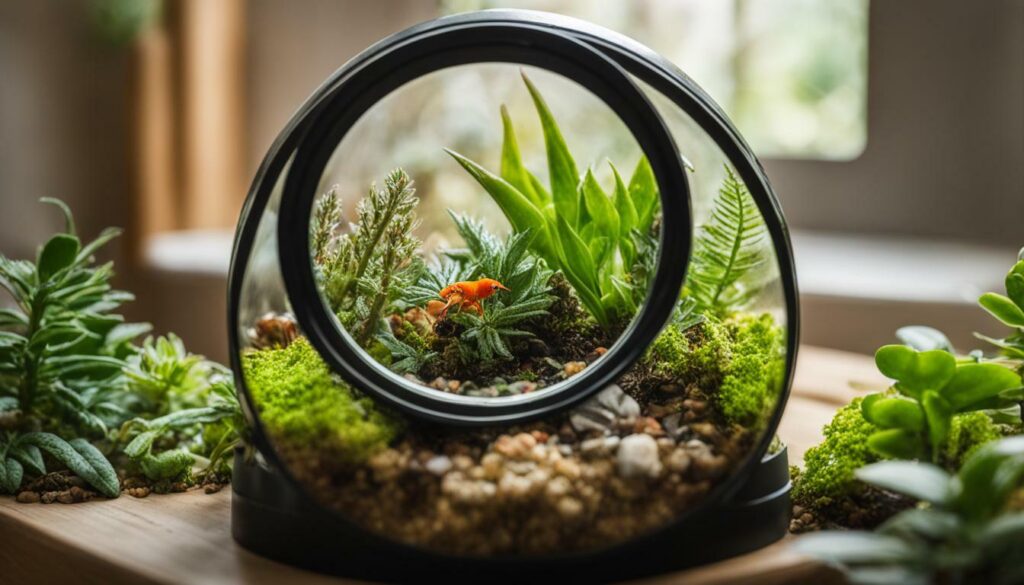
| Common Terrarium Pests | Treatment Methods |
|---|---|
| Aphids | Manual removal, insecticidal soap |
| Mealybugs | Manual removal, neem oil |
| Spider Mites | Insecticidal soap, rubbing alcohol spray |
| Fungus Gnats | Sticky traps, hydrogen peroxide drench |
- Regularly inspect your terrarium for signs of pests
- Identify and research treatment methods for specific pests
- Take prompt action to prevent further infestation
- Isolate infected plants to prevent spreading
- Clean and sterilize tools and equipment regularly
Remember, prevention is the best form of pest control. By providing your terrarium with the right conditions and consistently monitoring its health, you can create an environment that deters pests and promotes the thriving growth of your plants.
Summary
Regularly monitoring your terrarium is vital for identifying and addressing any pest issues before they become severe. Conduct routine inspections, identify pests, and research suitable treatment methods. Isolate infected plants and maintain good hygiene by cleaning and sterilizing tools. By practicing these proactive measures, you can keep your terrarium pest-free and enjoy a lush, thriving mini-ecosystem.
Are There Any Additional Pest Prevention Tips for Terrarium Care?
When it comes to expert terrarium pest control methods, there are a few additional prevention tips to keep in mind. Maintaining proper ventilation, using sterile soil, and regularly cleaning the terrarium can all help prevent pests from taking hold. Additionally, keeping an eye on your plants for any signs of pests is crucial for early intervention.
Conclusion
By following proper pest prevention techniques and maintaining a healthy terrarium environment, you can ensure the long-term health and vitality of your miniature ecosystem.
Maintaining a healthy environment for terrarium plants requires avoiding certain mistakes, such as placing them in direct sunlight or near heat sources like radiators. Proper lighting is essential, and supplemental light can be provided with grow lights or fluorescent lights. Cleaning the glass of the terrarium regularly is important for light penetration.
Over-watering should be avoided, and a spray bottle can be used instead of a watering can to prevent excessive moisture. Pruning and removing diseased plants promptly is necessary to prevent the spread of problems.
Selecting the right plants for the type of terrarium and ensuring they have similar light and moisture requirements is crucial. Succulents are not suitable for closed terrariums, as the humid environment is not ideal for them. In addition, the settling-in period of a new terrarium requires extra care and attention to ensure that the moisture and humidity levels are balanced.
Common issues such as mold, fungus, and pests can be addressed by maintaining proper ventilation, monitoring moisture levels, and practicing good hygiene. Regular maintenance, such as cleaning, pruning, and replacing dead plants, is necessary to keep the terrarium in good condition. If any issues arise, it is advised to consult the experts for guidance and assistance.
FAQ
What are some common mistakes to avoid in terrarium care?
Some common mistakes to avoid in terrarium care include placing the plants in direct sunlight or near heat sources, over-watering, and not cleaning the glass regularly for proper light penetration.
Can I use succulents in a closed terrarium?
No, succulents are not suitable for closed terrariums as the humid environment is not ideal for them.
How can I maintain proper lighting for my terrarium?
Proper lighting for terrariums can be achieved by placing them in an area with sufficient natural light or using grow lights or fluorescent lights as supplemental light sources.
What should I do during the settling-in period of a new terrarium?
During the settling-in period of a new terrarium, extra care should be taken to ensure balanced moisture and humidity levels by monitoring and adjusting as needed.
How can I prevent pests in my terrarium?
To prevent pests in your terrarium, it is important to maintain proper ventilation, monitor moisture levels, practice good hygiene by cleaning regularly, and promptly address any issues such as mould, fungus, or pests that may arise.
What should I do if I encounter pest issues in my terrarium?
If you encounter pest issues in your terrarium, it is advised to consult experts for guidance and assistance in effectively addressing the problem.
Why is regular maintenance important for terrarium care?
Regular maintenance, such as cleaning, pruning, and replacing dead plants, is necessary to keep the terrarium in good condition and prevent potential pest problems.

